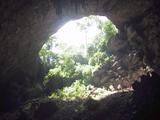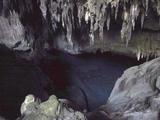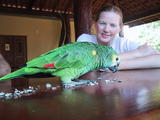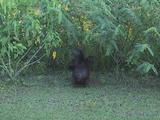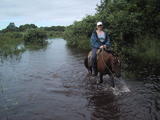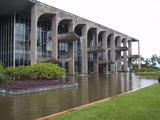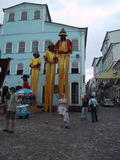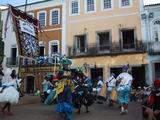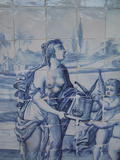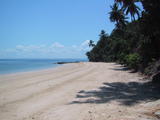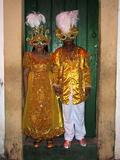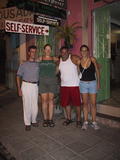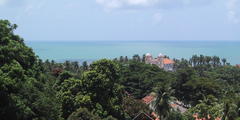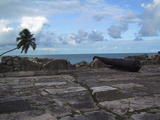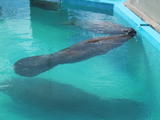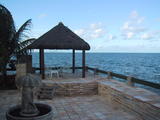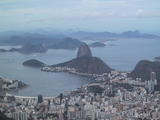| < < < Previous story | Next story > > > | |
Brazil: Bonito, the Pantanal, Carnival in SalvadorHolland, 4 April 2004
Contents:Bonito and the PantanalWe headed to Bonito after replenishing our depleted cash reserves in Campo Grande. Bonito is a town surrounded by many natural attractions, but strangely enough transportation to these attractions is not well organized. Even though all visits have to be booked through a local tour operator, every visit requires a taxi ride. We visited a cave with a blue underground lake and snorkeled down a crystal clear river with colorful fish. An impressive sighting was that of two toucans that settled in a tree next to our hostel. Besides the day time natural wonders the evenings turned out to be less than boring as well. The first evening, at the hostel, a Brazilian girl shamelessly showed us her photo album, of pictures of her and her drunken girl friends! On the second evening we tried some Brazilian drinks, downing a caipirinha or two (or was it three or four?) at a pub called Taboa. The waiters even took a picture of us... (Follow the link above and click on the big photo, fill in the date: 14/02/2004, then go to the second page). Traveling to and from Bonito involves a needlessly long bus ride to a town called Anastacio stopping in every village in the area. Trying to catch a connecting bus in Anastacio for Corumbá, in the Pantanal, failed because the outward bus was full so we had to spend one night in this town. When we finally arrived in Corumbá early the next afternoon, tour operators awaited us at the bus station. One of them had a group leaving that afternoon for a three day stay in the Pantanal. The Pantanal is South America's largest wetland, it is supposed to have a lot of visible wildlife, but we were a bit disappointed. As we drove to the camp we did see the world's largest rodent, called capybara, and loads of caimans. More impressively we saw 6 toucans land in a tree along the road. The excursions around the camp by contrast, yielded very little in the form of wildlife viewing in part due to 24 hours of heavy rainfall. During a fishing excursion, I caught a fish called a pacou, no one else, even the guide, caught anything. We looked on as the guide efficiently butchered the poor animal. "It's natures way" he said. Fortunately some in our group were vegetarians leaving more of the fish for those who weren't. Horseback riding was another interesting experience. As it had rained a lot, the horses had to ride through water which at one point it was so deep that they had to swim with us on their backs! A dog that followed us from the camp, often swimming alongside the horses, probably chased away any wildlife that was there. We only saw a few birds. Impressive was the rain storm, which started as we attempted to go horseback riding the first time and lasted until early the next morning. It left us soaking wet and later shivering in our hammocks. Carnival in SalvadorFrom the Pantanal we had to travel to Salvador, on the other side of the country, in time for Carnival. We first had to return to Campo Grande where we spent our only night in one whole week in decent beds. The next morning we embarked on a two day bus journey across Brazil via the capital Brasilia, where we had a 7 hour stop over. We had to go by bus because all flights were fully booked or too expensive due to the start of Carnival and we had simply waited too long to arrange them. Fortunately we were accompanied by Peter and Sarah whom we had met in the Pantanal. During our stopover in Brasilia we visited some of the sights. The place is artificial (the city did not grow organically but was planned). Buildings are far apart so you can not reasonably walk from one place to the other. The elevator to the panorama platform in the TV tower was broken as well. The last leg of our bus journey, from Brasilia to Salvador, was undoubtedly the most entertaining. People could not wait for carnival in Salvador, so it started right there on the bus, men and women, gay and straight, shaking their bodies to the rhythm of samba into the early hours. Since we had already booked an apartment for the two of us in Salvador, Peter and Sarah went to find their own place to stay. The next day we received an E-mail from them that Peter had been attacked by a group of men and ended up in the hospital. They decided to leave Salvador. As we were walking through the crowds, I felt someone's hand enter into my pocket. I grabbed hold of it and immediately all his "friends" came to help him, all shouting at me. Being outnumbered I decided to let the guy go. This incident and what happened to Peter and Sarah made us extremely aware of the dangers around Carnival. To avoid any problems we decided to take as little with us as we could. Just a few Reals in our pockets for drinks and some more hidden in our shoes for dinner. We also decided not to drink alcohol as this makes you weaker and therefore more of a target. We also choose not to take our camera as no-one else was carrying one either. As a result though we have no pictures of most of these events. But the real theft was the apartment, which was not an apartment at all! We had paid 1000 Reals for it, with the promise to have an apartment to ourselves. When we got there there were 10 other people in a 3 room apartment, the bed broke as soon as we sat on it, the door knob fell off, the electric shower stopped heating after 2 minutes and the ventilator burnt out in the middle of the night, leaving a horrible smell. Since they had told us, it was an apartment just for us we complained and complained. Reluctantly they fixed the bed by the 3rd night! When we came home after the first night of Carnival we found a young dog in the kitchen tied with a 50cm leash, unable to get to his food or water. So I released the animal. The next day the poor animal was tied up again, so I asked them why. They told us it was so that he would not bother us! But it bothers us much more to see an innocent young dog, who only wants to play, suffer!!! So we told them not to tie up the dog for our sake. Then there were also 5 children, looking at us as if we had stolen their room. This was technically the fault of their parents, but made our stay even more uncomfortable. All in all the "apartment" was a disaster, we felt cheated and uncomfortable, but fortunately we could spend most of our time outside enjoying carnival. In Salvador carnival lasts 6 days of which we experienced the last 4. There are three parade circuits through the city. Two of which consist of trucks pulling a band or live act behind it, while the circuit in the old town was more traditional with musicians going on foot. A group of musicians with or without a truck is called a bloco. The truck blocos start the circuit at intervals taking hours to complete the circuit. At three in the morning there are still trucks waiting to start the circuit! You can follow a specific bloco if you like their music, or wait by the side of the circuit for the blocos to pass. We were advised by Brazilians we had met earlier in our travels that Salvador and Recife had the best carnivals. Sure enough Salvador is the official birthplace of Brazilian carnival. Rio just copied it from them. Although I have no idea what the Rio carnival is like, Salvador is said to be better: more in the streets, more spontaneous and more authentic. During carnival the whole town is in a trance, nothing else matters. There is also a significant gay section in this carnival, where you may suddenly be kissed on the cheek by a man dressed as a woman. Brazil is probably the only country in South America where homosexuality can be so openly displayed, the country definitively scores points for tolerance. We stayed in Salvador for a few more days after carnival to see the city and some of its surroundings. A most interesting church was the church of São Francisco, which had been built by African slaves. As it was not their own religion they had made angels with sex organs while others look pregnant! The Portuguese had brought African slaves, because they were more resistant to European diseases and more able to withstand the harsh working conditions on the sugar plantations than Indians. Nowadays the Brazilian Northeast is a peaceful melting pot of Indians, Europeans and Africans and you can see how they have mixed over the years to form a rainbow of skin colors. Olinda and RecifeContinuing along the northeast coast we flew to Recife and made our way to the nearby town of Olinda. A town which had been completely burned down by Dutch invaders in 1631. Unexpectedly we stumbled into another night of Carnival. These people never stop! It was different from Salvador, more inclusive of people of all ages, not just for the young. Participants were dressed up colorfully. Also unlike Salvador people had their cameras with them without fear of them being stolen. We visited the Sunday handicraft market (Domingo Na Rua) in Rua Bom Jesus in Recife, which is a pleasant area where many restaurants are located as well. At night the nearby observatory tower had set up telescopes, pointed at Jupiter and the Moon, for visitors to look through. ItamaracáWe decided that we needed some rest as well during our last days in South America, let's say that needed a vacation from all the traveling! We chose the island of Itamaracá for this purpose. We were fortunate to find a newly opened Pousada, Pousada Estrelas, located on the beachfront. A quiet and clean place with a pool and a relaxing seafront area where you could sit sipping a drink or reading a book while the waves continued endlessly to stroke the beach. We spent 5 days there, but also explored the island a bit. There is fort built by the Dutch United India Company in 1630 during their occupation of the area. Apparently the shareholders later voted to abandon the colony as the costs far outweighed the profits they made from the sugar plantations. There is a "green train" on the island, actually a small truck pulling an open trailer where you can sit. The "train" drives along the road from fort Orange to the beach at Jaguaribe. The fort was nice to see, especially since it had something to do with my native country. The snorkeling and mangrove excursions were disappointing, hardly worth the time spent. More interesting was the Marine mammal conservation project called projeto Peixe-Boi. A project that is trying to save the last manatees (sea cows) in Brazil. These docile creatures are easily caught and therefore face imminent extinction. In Brazil there are said to be only 500 left in the wild. The entry fee was ridiculously low, so we felt the need to buy something in their souvenir shop to support the project. We talked a lot with Fabricio and Mara, the owners of the pousada, us speaking Spanish with a few Portuguese words we knew here and there, them speaking back in Portuguese. It went surprisingly well, at least when then sentences were spoken slowly and were not too long. They had moved from 3000 km south in Brazil to Itamaracá to start the pousada, leasing the building for 4 years, hoping to make something of it. I always have respect for people who are trying to build up something and do something new with their lives. I wish them all the success they can have, but I think it will be difficult because there is not that much tourism on the island. It seems that tourism to the island has collapsed several years ago. There are many abandoned buildings, some of them quite large and modern. No one offers Internet access on the island and restaurants are scarce. Rio de JaneiroAfter five days vacation from our travels we returned to Recife to catch a flight to Rio de Janeiro. We spent only two days in Rio and one in Sao Paulo. Enough to see all the sights in Rio, the standard stuff, that is: going up to the statue of Christ the Redeemer on Corcovado by cog train, a stroll along Copacabana and the view over Rio from on top of Sugarloaf at night fall. It seemed that everybody we had talked to about Rio in the past had told us it was a very dangerous city, so we were very careful. And the news is that nothing happened, we were not robbed or mugged. The only incident was with a taxi driver, the guy refused to put on the meter for what we knew would be about a 7 Real metered ride and instead asked 20 Reals. I told him, in Spanish, that he either had to put on the meter or stop if he did not want to transport us, so reluctantly he put the meter on but started an endless list of complaints about such things as that all tourists pay 20 Reals and that Rio was the most beautiful city in the world and therefore we had to pay more. So I interjected, again in Spanish, that Rio was too expensive and that Buenos Aires was much cheaper. At the end in spite of the meter saying that we had to pay 6 Real, plus the 1 Real official rate hike, the guy had the nerve to ask 10. Having pissed us off there was no way in the world he would get it. He insisted, so I got out and called the nearest policeman to help us. The policeman ordered the taxi driver to give us back 3 Real from the 10 Real bill we gave him. Then my comment about Buenos Aires came back in a funny way, the taxi driver said to the policeman, in a way that was supposed to explain it all: "They are Argentinians!" Summing it all upIn one way that taxi driver was right, we had loved Argentina, it may be the best bargain in South America at this time. Rarely have we visited countries were the food was so delicious that it was in itself reason enough to justify a visit. There was the lively nightlife in Buenos Aires where you can feel very much at ease and relatively safe, the endless nature, the Perito Moreno Glacier, the Andes, the peace and quiet of Ushuaia and the ease with which you can fly throughout the country for relatively low fares to see all these things. After visiting Buenos Aires, three times during this trip, the city made it to the top 10 of my favorite cities to live in. Now that our South American trip is over, here are the highlights according to me: the Galapagos, the Nazca lines, Machu Picchu, the Uyuni desert, the Perito Moreno Glacier, the ferry through the Chilean fjords Buenos Aires nightlife, Argentinian food, Iguazu and Carnival in Salvador. We came back with 1700 photos plus 200 more from Erik, who traveled with us for six weeks. It has cost me days to process them, sort them, cut them and convert some of them for use in our on-line travel stories. All the while seeing over and over again all the beautiful things we saw. Thankfully we will continue to travel otherwise these memories, so great as they are would make me depressed, especially while staring out of an office window into the rainy cold winter weather outside. How to deal with the emotional backlash that you are bound to get when you stop traveling is an issue that we are well aware of. We cannot just return to the old life we had and continue as if this has all just been a dream. For the moment, we are still traveling, in a classic case of missed deadlines our trip starts to look like an IT project of a major bank. The first plan was: 6 months in South and Central America, starting in Brazil, followed by 6 months in Southeast Asia. Instead we started in Guatemala to learn some Spanish originally for one month or so, planning to end up in Brazil after 6 months, from where we would travel on to Southeast Asia via Europe. It was not to be, after spending 2 months learning Spanish in the town of Antigua Guatemala we did a 1 month tour through Mexico, Guatemala and Belize only to return to Antigua, where we spent nearly another 2 months learning more Spanish, before finally heading south. More than six months into our trip we had just reached Panama! Instead of continuing to South America, we first flew back to Europe, where we spent nearly a month in the Balkans and two months in Estonia. After the European summer was over we finally went to South America. This was actually very convenient as we spent the southern summer months in South America, this was especially nice for Patagonia. But we are now already 15 months into our trip, 16 months since my last day at the office, and only now have we finally completed what we had wanted to do in the first 6 months! What is next? Maris has just started her teaching practice in Estonia, where I will join her in June in time to be at Eva and Jason's wedding party and to observe the Venus transition on June 8th, a rare astronomical event, when the planet Venus passes in front of the Sun. After that the plan now is to go to Asia, possibly starting in Mongolia in August and ending in India in April 2005. If you would like to receive (or stop receiving) notifications of updates just send me an e-mail. e-mail Otto de Voogd PhotosBonitoPantanalBrasiliaSalvador da BahiaOlinda and RecifeItamaracáRio de JaneiroPractical Information
To my knowledge the information provided here was accurate
at the time of our visit. However time passes and things can change.
TransportationStrangely enough it is impossible to purchase airline tickets online with a non-Brazilian credit card! But many travel agents in Brazil, can book through Internet for you (even at web-rates). Admittedly this does make it difficult to purchase before arriving in Brazil. MoneyFew ATMs in Brazil accepted our Maestro bankcards, the ones who did are from HSBC, of which there is fortunately one branch in every big city, Citibank, which has fewer branches, some of Banco do Brazil's ATMs, usually at airports and some stand alone banco24horas ATMs, but these charge 6 R$ (Brazilian Reals) for the privilege. All ATMs limit withdrawals to 1000 R$, but Citibank allowed multiple withdrawals. CostsBrazil - Reais, approx. rates: 1 USD = 2.95 BRL, 1 EUR = 3.67 BRL
Bus - Campo Grande -> Bonito: 33 BRL
| ||
| < < < Previous story | Next story > > > | |
New | About | Contact | Connect | Friends | Promotions | Copyright | Advertise

